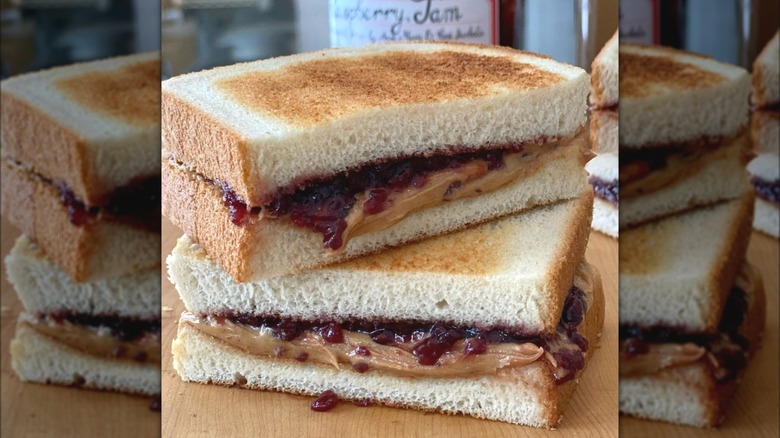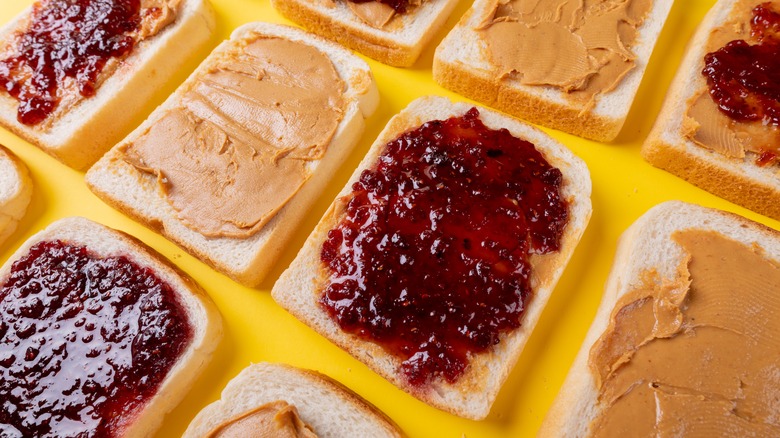Why Ina Garten's PB&J Is Better Than Yours
A PB&J might as well be the textbook example of a sandwich, especially if your schooldays were split up with one. Jammed with nostalgia through salty peanut butter and sweet jelly, it's a classic staple for all kinds of occasions — from sack lunches to camping trips. It's easy to put together and enjoy anywhere, and the peanut butter and jelly sandwich has a humble history rooted in its cheapness and convenience. However, with a popularity that still persists, it's nothing to scoff at. If you take sandwich-making seriously or simply want to indulge in a satisfying snack on a sunny afternoon, it's worth learning how to make the best possible PB&J. While technique is important, celebrity cook and author Ina Garten emphasizes the importance of ingredients.
As the award-winning host of heartwarming television programs, from Food Network's must-watch "Barefoot Contessa" to the star-studded (and sometimes tear-jerking) "Be My Guest with Ina Garten," she has spent the past two decades sharing recipes and cooking tips with viewers. After all this time, she has left few foods unmade — including the humble PB&J. In an Instagram post from 2021, she shared photos of her take on the sandwich, which she prepared for a sweet lunch date with her husband, Jeffrey. So, what are Garten's secrets for a perfect PB&J? The answer lies in the specific — and store-bought — ingredients she uses. Yes, that means you can easily recreate her version of the sandwich at home, just like so many of her signature dishes.
The ideal ingredients for this classic sandwich
To make a mouth-watering peanut butter and jelly sandwich that's as satisfying in flavor as it is in texture, Ina Garten did her due diligence to track down the best ingredients. Her big three, according to Today: Pepperidge Farms white bread, Skippy creamy peanut butter, and Eli Zabar's seeded raspberry jam. All of them are store-bought, so there's no need to sweat about making homemade nut butter or learning how to can jam for this simple sandwich.
While some people might swear by whole wheat bread, especially if the goal is eating healthy, any food can be enjoyed in moderation — including thick and fluffy white bread. Garten opts to toast each slice, providing a bit of crunch to contrast with the smooth peanut butter. This also prevents the spreads from making the bread soggy before you get to savor the first bite. And if you usually pick up a jar of Jif peanut butter, it's worth trying out Skippy for a change; creamy not crunchy. Although if you're particularly picky or prone to testing textures, try both options. When it comes to the sweet stuff, Garten splurges on Eli Zabar's fruit jam, which is costly at $28 for a 16-ounce jar. The investment is only risky in the sense that you may discover a new favorite condiment. If Garten's preferred flavor of raspberry isn't to your taste, the delicious fruit spread also comes in apricot, strawberry, blueberry, and fig.
The optimal ratio of peanut butter to jelly
While Ina Garten's advice starts and ends with the exact ingredients for her version of the scrumptious yet simple sandwich, it's worth reflecting on how much of each to use. As with any sandwich that contains spreadable ingredients, determining the right amount you should slather onto a slice of bread is essential to the whole eating experience. The ratio of peanut butter and jelly is especially important, though the internet is seemingly split about the ideal proportion. Skippy, Garten's preferred peanut butter provider, recommends a one-to-one ratio, with 2 tablespoons of each spread. Other recipes might call for more peanut butter and less jelly, suggesting a two-to-one ratio — or even 2 tablespoons to 2 teaspoons.
Depending on whether or not you're fond of peanut butter stuck to the roof of your mouth, the optimal ratio might be more subjective. The same goes for if you prefer a particularly sweet rather than salty sandwich. More fruit spread means you'll need to stock up on premium jelly sooner, but an open jar of peanut butter lasts a while, depending on how it's stored. Ultimately, the best tip for achieving the right ratio is to start slow with the slathering — you can always add more as you go. Beyond that, feel free to follow your heart or, more accurately, your tastebuds. As warm and personable as Ina Garten is on the screen, she'd certainly support your quest to perfect the PB&J based on your preferences.


